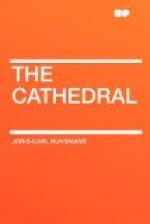“This archaeologist’s ideas, in fact, cannot be maintained. He subordinates leading features to accessory details, and ends in a kind of rationalism entirely opposed to the mysticism of the period. He investigates the Middle Ages by levelling down the divine idea to the lowest earthly meaning, and referring to man what is intended to apply to God. The prayer of sculpture, chanted by the ages of faith, becomes, in the introduction to his work, nothing more than an encyclopaedia of industrial and moral teaching.
“Let us look closer at all this,” Durtal went on, and he went out to smoke a cigarette on the Place. “That royal doorway,” thought he, as he walked on, “is the entrance to the great front by which kings were admitted. It is likewise the first chapter of the book, and it sums up the whole of the building.
“But certainly these conclusions forestalling the premisses are very strange; this recapitulation, placed at the very beginning of the work, when it ought, in fact, to be placed at the end, in the apse!
“And yet,” he reflected, “putting this aside, the facade thus worked out fills the position in this basilica which the second of the Sapiential Books holds in the Bible. It answers to the Book of Psalms, which is in a certain sense an epitome of all the Books of the Old Testament, and consequently, at the same time, a prophetic memento of the whole of revealed religion.
“The western side of the cathedral is similar; only, it is a compendium not of the older but of the newer Scriptures; an epitome of the Gospels, an abridgment of the books of St. John and the synoptical Gospels.
“In building this, the twelfth century did more. It added more details to this glorification of Christ, following Him from before His birth, through the Bible story, till after His Death and to His Apotheosis as described in the Apocalypse; it completed the Scriptures by the Apocryphal writings, telling the tale of Saint Joachim and Saint Anna, recording many episodes of the marriage of the Virgin and Joseph derived from the Gospel of the Nativity of the Virgin and pseudo-Gospel of St. James the Less.
“But, indeed, in every early sanctuary such use was made of these legends, and no church is really intelligible when they are ignored.
“Nor is there anything to surprise us in this mixture of the authentic Gospels and mere fables. When the Church refused to recognize by canonical authority the divine origin of the Gospels of the Childhood, of the Nativity, the writings of St. Thomas the Israelite, of Nicodemus, of St. James the Less, and the History of Joseph, it had no intention of rejecting them altogether, and consigning them to the limbo of inventions and lies. In spite of certain anecdotes which are, to say the least of it, ridiculous, there may be found in these texts some accurate details and authentic narratives which the Evangelists, cautiously reticent, did not think proper to record. The Middle Ages by no means lent themselves to heresy when they ascribed to these purely human Scriptures the value of probable legend and the interest of pious reminiscence.




